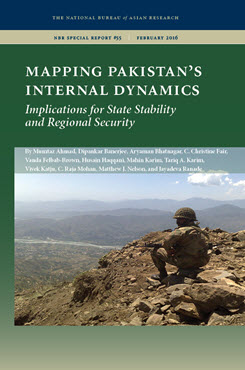Mapping Pakistan's Internal Dynamics
Implications for State Stability and Regional Security
This is the introduction to the report “Mapping Pakistan’s Internal Dynamics: Implications for State Stability and Regional Security.”
Note: The following is an excerpt from the introduction. Download the PDF to read the full introduction.
This NBR Special Report is the culmination of a two-year research project by the National Bureau of Asian Research (NBR) that sought to analyze Pakistan’s internal security landscape and external geopolitical environment. Funded with generous support from the John D. and Catherine T. MacArthur Foundation, the project convened an international team of experts to author the essays presented in this report. These essays were informed by a series of workshops and briefings held in New Delhi and Washington, D.C., in partnership with the Observer Research Foundation.
Project Rationale
Pakistan today represents one of the world’s most significant and vexing geopolitical challenges. Its geographic position at the nexus of the Middle East and Asia, its nuclear stockpile, and the strength and determination of domestic extremist groups make Pakistan’s future course a top geopolitical priority for the United States. Looming instability inside Pakistan profoundly threatens U.S. interests in regional stability, nonproliferation of weapons of mass destruction, and the eradication of extremism. An unstable Pakistan—a state that is riven by internal factionalization and radicalization, possesses a nuclear stockpile that may not be secure from terrorist groups, and finds its very existence as a viable, secular state threatened—would have profound implications for the security interests of the United States and the geopolitical stability of the Middle East and Asia.
As the United States and NATO withdraw the bulk of their military forces from Afghanistan, Pakistan will be a key player in preserving regional stability. As such, ensuring Islamabad’s continued strength and viability will be a necessary first step for the United States toward achieving broader national security objectives. Yet persistent suggestions of complicity between elements of the Pakistan military and intelligence services and various terrorist organizations have exacerbated the already profound concerns about Islamabad’s weak control over frontier provinces, the spillover of Taliban and other Islamist elements across the Afghan border into Pakistan, and the realization that many of these groups have been harbored and to a degree controlled by forces within Pakistan’s military-intelligence establishment to further the country’s strategic goals.
Thus far, India in particular has borne the brunt of Pakistan’s dichotomous political culture. New Delhi’s state-level negotiations with the civilian government in Islamabad toward better relations between the two countries have been rendered almost farcical by the activities of subversive elements within Pakistan’s military-intelligence establishment to scuttle any such attempts at closer ties. Pakistan’s so-called successful democratic transition in May 2013 and the newly elected government of Prime Minister Nawaz Sharif and his Pakistan Muslim League–Nawaz (PML-N) party, brought some measure of hope. During his prior tenure as prime minister (1997–99), Sharif was credited, along with then Indian prime minister Atal Bihari Vajpayee, with normalizing relations between the two countries to a degree not experienced since their respective independence from British India. Those efforts were, of course, derailed by the 1999 Kargil War that was spearheaded by then Pakistan army chief Pervez Musharraf, who subsequently ousted Sharif from power and exiled him to Saudi Arabia in a military-backed coup. Perhaps it is no small wonder then that the recent overtures by Sharif and the new civilian government in Pakistan toward better relations with India have been overshadowed by an upsurge in infractions across the Line of Control (LoC) in Kashmir, once again bringing to light the opposing centers of power at play in Pakistan.
Yet Pakistan’s instability is not solely an Indian problem. Should Islamabad’s power continue to disintegrate, the control and security of Pakistan’s nuclear forces grow increasingly uncertain, and extremist forces strengthen, instability could quickly spread across South Asia and the Middle East. While the Pakistani Taliban (Tehrik-i-Taliban Pakistan, or TTP) have since their inception in 2007 primarily targeted their efforts domestically against the Pakistani state, there have recently been indications of plans for the TTP to expand the scope of activities beyond Pakistan. In a show of solidarity with al Qaeda and other jihadist groups, the Pakistani Taliban have already expanded their operations beyond Pakistan’s borders to assist rebels fighting against the Assad regime in Syria. Further, the TTP also threatened to attack Myanmar in the wake of sectarian violence against Rohingya Muslims in that country. Reports of the Islamic State of Iraq and Syria (ISIS)—which already has sympathizers among Pakistani extremist elements—possibly expanding its scope of operations into Pakistan are cause for further alarm. The stakes for both the country and the region thus could not be higher.
Mahin Karim is Senior Associate for Political and Security Affairs at the National Bureau of Asian Research (NBR) and Research Director for the project “Mapping Pakistan’s Internal Dynamics: Implications for State Stability and Regional Security.”


